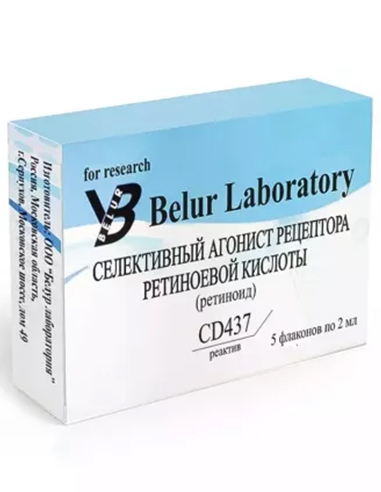Second generation retinoids are drugs that are intended to treat psoriasis, lupus erythematosus and ichthyosis. This is a synthetic derivative of retinoic acid, in which the content of the active substance is increased by 25 times. The drugs are available in capsule form.
CD437 is a retinoid-like small molecule that is considered a novel means of treating cancer by inducing apoptosis in cancer cells. Simply put, harmful cells simply disintegrate into poorly protected bodies, because the number, and, consequently, the activity of metabolic enzymes increases with the help of retinoid CD437. The ability to use so-called “programmed cell death” is an important task in the treatment of cancer. At the same time, the drug is completely free of toxicity.
This semi-synthetic substance is obtained from a plant base. The chemical substance belongs to a large group of carotenoids, of which about 1,500 species are known. By the way, these include vitamin A. One of their subgroups belongs to retinoids. These include retinoid CD437.
It has been experimentally established that this substance is actually a genetic key, a master key for cancer cells, encouraging them to switch to the path of triggering blocked cancer cells to apoptosis, that is, a self-shutdown mechanism intended by nature, self-destruction of patients affected by viruses or genetic damage to cells. The optimal mechanism chosen by nature is not the mechanism of repair of cancer cells into healthy ones, but the mechanism of their apoptosis.
ACTION
Induces cell cycle arrest and also stimulates apoptosis - programmed cell death, which leads to the “careful” disassembly and removal of cancer cells;
Reduces the expression of matrix (or informational) RNA, an acid that regulates the expression of genes. This concerns squamous cell differentiation, when it is important to study the histogenesis of the tumor - all the processes that are responsible for the formation and restoration of tissues. In other words, it is necessary to establish the direction of “reincarnation” of the functions, forms and metabolic activity of “hostile” cells;
Binds to nuclear receptors of retinoic acid (RAR-beta and RAR-gamma), which change gene expression, as well as protein synthesis and maturation, cell differentiation, activating the above-mentioned receptors. (You can find more information on the website svetlov.com.ua) Thus, retinoid CD437 is a complete inducer of apoptosis inside cancer cells. For example, the retinoid CD437 promotes apoptosis of lung cancer cells, which become more sensitive under: a) serum-free conditions, which are favorable for epithelial cell growth. Cancer cells in the absence of serum become more sensitive to CD437. However, in studies, CD437 showed little or no growth inhibition in lung epithelial cells. What causes a given retinoid to “weaken”? Unknown. Perhaps the reason for this is a protein (albumin) that reduces the concentration of CD437 when accessing the body (cells). Also, for example, serum-free conditions allowed CD437, even at 0.2 μM, to cause the majority of tumor cells to detach and float; b) in the presence of 5% serum (which is beneficial for the growth of cancer cells), studies have shown that CD437 inhibited (reduced or suppressed) the growth of cancer cells by 30 ... 80%;
The action of the substance CD437 is selective - healthy epithelial cells are not affected at all.
INDICATIONS
The spectrum of activity of retinoid CD437 is oncological diseases:
Brain;
Mammary gland;
Lungs;
Melanoma;
Skin (basal cell carcinoma, squamous cell carcinoma);
Prostate;
Uterus;
Colon;
Bladder;
Larynx, oral cavity, esophagus, stomach;
Metaplasia, dysplasia (improper development of tissues, organs and body parts), neoplasia (formation and growth of tumor tissue);
Leukoplakia;
Papillomas of the mucous membranes;
In the treatment of Kaposi's sarcoma;
Circulatory and lymphatic systems;
Myeloid cell lines, that is, blood cells that inhibit the activity of the immune system.
All retinoids, including CD437, are important for the functioning of the entire body.
For example, this substance is necessary for:
Treatment of eye diseases (retinal detachment, various types of corneal changes, for example);
Treatment of Sjögren's syndrome;
Regulation of proliferation – growth of body tissue through cell division;
Cell differentiation. This is the birth of specialized cells that acquire certain chemical and functional characteristics. In other words, this is, firstly, a local adaptation of the cell relative to the needs of the body, and secondly, it is the implementation of programmed and specialized functions of the cell;
Development of bone tissue;
Activation of tumor suppressor genes;
Preventing cardiovascular diseases (improving lipid metabolism, for example).
Also, the substance CD437 prevents diseases that are associated with the papilloma virus, including:
Warts and genital warts;
Various inflammatory diseases (colitis, Crohn's disease);
Neurodegenerative diseases (Alzheimer's disease, Parkinson's disease);
Problems with the functioning of the pituitary gland (insufficient production of growth hormone, for example);
Various diseases of the immune system.
This is why CD437 retinoid is used as an immunosuppressant and immunostimulant.
CONTRAINDICATIONS
Pregnancy and lactation;
Kidney diseases;
Liver diseases.
POSSIBLE SIDE EFFECTS
Dryness and flaking of the skin, blistering;
Increased sensitivity to sunlight;
Increased body temperature, shortness of breath;
Increased pressure;
Itching and burning of the skin;
Vomiting, diarrhea;
Dizziness, arrhythmia, chest pain, weakness.
INSTRUCTIONS FOR USE
The course of retinoids can range from 3 months to six months. Usually the drug is recommended to be used once a day - at night.
Treatment with retinoids should be carried out strictly after prescription and under the supervision of a specialist!

